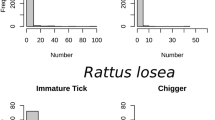Abstract
In experimental systems of a bruchid host, Callosobruchus chinensis, and a braconid parasitoid, Heterospilus prosopidis, the effects of changes in developmental schedules were examined in relation to the persistence of the system, or the time to extinction of a component species. We modified the developmental schedules by changing the temperature from 30°C to 32°C. To compare persistence, a long-term system with overlapping generations was set up and the bruchid host resource, azuki beans (Vigna angularis), were renewed every 10 days. The long-term systems showed greater persistence at 30°C than at 32°C. Parasitoid extinction was often observed. We examined differences in life-history characteristics of the component species between the two temperatures by short-term, single-generation experiments. Fecundity and egg hatchability of the host were reduced and the developmental period of the parasitoid was shortened at 32°C. The age at which the host became vulnerable to parasitoid attacks was earlier at 32°C than at 30°C. We constructed a daily based, age-structured model to analyse which life-history change(s) affected the persistence of the long-term systems. The density-dependent population growth of the host was described by a logistic equation and the attack rate of the parasitoid by a type II functional response with mutual interference. The simulation results showed greater persistence at 30°C than at 32°C. Sensitivity analysis showed that there are threshold boundaries in the length of the vulnerable period of the host beyond which system persistence drastically changes. Further, persistence at another temperature, 28°C, was predicted using a model based on short-term data on the host.
Similar content being viewed by others
References
Begon M, Mortimer M (1986) Population ecology: a unified study of animals and plants. 2nd edn. Blackwell, Oxford
Bellows TS, Hassell MP (1988) The dynamics of age-structured host-parasitoid interactions. J Anim Ecol 57:259–268
Briggs CJ, Nisbel RM, Murdoch WW (1993) Coexistence of competing parasitoid species on a host with a variable life cycle. Theor Popul Biol 44:341–373
Fujii K (1983) Resource dependent stability in an experimental laboratory resource- herbivore-carnivore system. Res Popul Ecol Suppl 3: 15–26
Godfray HCJ, Hassell MP (1987) Natural enemies may be a cause of discrete generations in tropical insects. Nature 327: 144–147
Godfray HCJ, Hassell MP (1989) Discrete and continuous insect populations in tropical environments. J Anim Ecol 58: 153–174
Gordon DM, Nisbet RM, De Roos A, Gurney WSC, Stewart RK (1991) Discrete generations in host-parasitoid models with contrasting life cycles. J Anim Ecol 60: 295–308
Hassell MP (1975) Density-dependence in single species populations. J Anim Ecol 44: 283–295
Hassell MP, May RM (1973) Stability in insect host-parasite models. J Anim Ecol 42: 693–736
Houghton JT, Jenkins GJ, Ephraums JJ (1990) Climate change: the IPCC scientific assessment. Cambridge University Press, Cambridge
Howe RW, Currie JE (1964) Some laboratory observations on the rates of development, mortality and oviposition of several species of Bruchidae breeding in stored pulses. Bull Entomol Res 55: 437–477
Kishimoto R (1953) On the individual variation of several morphological and physiological characters under different environmental conditions (Japanese with English summary). Res Popul Ecol 2:65–78
Kistler RA (1985) Host-age structure and parasitism in a laboratory system of two Hymenopterous parasitoids and larvae of Zabrotes subfasciatus (Coleoptera: Bruchidae). Environ Entomol 14: 507–511
Loader C, Damman H (1991) Nitrogen content of food plants and vulnerability of Pieris rapae to natural enemies. Ecology 72: 1586–1590
Munster-Swendsen M, Nachman G (1978) Asynchrony in insect host-parasite interaction and its effect on stability, studied by a simulation model. J Anim Ecol 47: 159–171
Murdoch WW, Nisbet RM, Blythe SP, Gurney WSC, Reeve JD (1987) An invulnerable age class and stability in delay-differential parasitoid-host models. Am Nat 129: 263–282
Shimada M (1989) Systems analysis of density-dependent population processes in the azuki bean weevil, Callosobruchus chinensis. Ecol Res 4: 145–156
Shimada M, Fujii K (1985) Niche modification and stability of competitive systems. I. Niche modification process. Res Popul Ecol 27: 185–201
Tuda M, Shimada M (1993) Population-level analysis on reduction in equilibrium population size of the azuki bean beetle. Res Popul Ecol 35: 231–239
Utida S (1944) Host-parasite interaction in the experimental population of the azuki bean weevil, Callosobruchus chinensis (L.). II. The effect of density of parasite population on the growth of the host population and also of the parasite population (in Japanese with an English summary). Oyo-Dobutsu 15: 2–18
Utida S (1956) Long-term fluctuation of population in the system of host-parasite interaction (in Japanese with an English summary). Res Popul Ecol 3: 52–59
Utida S (1957a) Cyclic fluctuations of population density intrinsic to the host-parasite system. Ecology 38: 442–449
Utida S (1957b) Population fluctuation, an experimental and theoretical approach. Cold Spring Harbor Symp Quant Biol 22: 139–151
Utida S (1971) Influence of temperature on the number of eggs, mortality, and development of several species of bruchid infesting stored beans. Appl Entomol Zool 15: 23–30
Utida S, Nagasawa S (1949) On the developmental period and that of adult life of Neocatolaccus mamezophagus, a pteromalid parasite of the azuki bean weevil (in Japanese). Kontyu 17: 7–21
Varley GC, Gradwell GR (1968) Population models for the winter moth. Symp R Entomol Soc London 4: 132–142
Wilkinson L (1992) SYSTAT for the Macintosh, version 5.2 SYSTAT, Evanston
Author information
Authors and Affiliations
Rights and permissions
About this article
Cite this article
Tuda, M., Shimada, M. Developmental schedules and persistence of experimental host-parasitoid systems at two different temperatures. Oecologia 103, 283–291 (1995). https://doi.org/10.1007/BF00328616
Received:
Accepted:
Issue Date:
DOI: https://doi.org/10.1007/BF00328616




